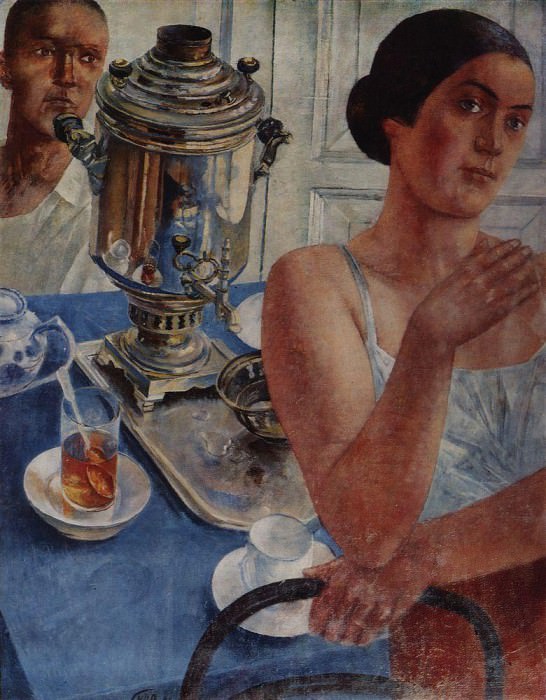For the samovar. 1926 Kuzma Sergeevich Petrov-Vodkin (1878-1939)
Kuzma Sergeevich Petrov-Vodkin – For the samovar. 1926
Edit attribution
Download full size: 780×1000 px (0,1 Mb)
Painter: Kuzma Sergeevich Petrov-Vodkin
Location: The State Tretyakov Gallery, Moscow (Государственная Третьяковская галерея).
Kuzma Petrov-Vodkin was a Russian artist who painted in the spirit of symbolism, using for his paintings some images from Russian folk tales - animals, people in unusual settings. Viewers of the last century know the artist as the author of "Bathing the Red Horse," a popular painting in the Soviet Union, but the artist had many other remarkable works, one of which is the painting "Behind the Samovar," written in 1926. In the foreground of the picture there is a girl - a woman in a light-colored blouse, exposing her full hands and beautiful swan neck.
Description of Kuzma Petrov Vodkin’s painting Behind the Samovar
Kuzma Petrov-Vodkin was a Russian artist who painted in the spirit of symbolism, using for his paintings some images from Russian folk tales - animals, people in unusual settings. Viewers of the last century know the artist as the author of "Bathing the Red Horse," a popular painting in the Soviet Union, but the artist had many other remarkable works, one of which is the painting "Behind the Samovar," written in 1926.
In the foreground of the picture there is a girl - a woman in a light-colored blouse, exposing her full hands and beautiful swan neck. The girl’s hair is pulled back and twisted into a tight hairstyle. The viewer can see only half of the girl’s body, with one hand resting on her chest and the other on the back of her chair. Behind the girl’s back there is a set table covered with a blue tablecloth.
The main place on the table and almost in the center of the picture is occupied by a large shining samovar, and glasses and cups with hot tea are placed around it. Behind the samovar the viewer can clearly see the face and figure of the second participant of the tea party, whose pensive look indicates that the people gathered at the table and visible to the viewer are not the only people in the room.
Most likely, there is a third interlocutor, whose story they have gathered to listen to with great attention and interest. This is also evidenced by the posture of the girl, who turned away from the table and froze in anticipation. One can also see the reflection of the third person present in the lustrously polished samovar, which in the pre-revolutionary era was used to get only on special occasions, which, apparently, is the arrival of the guest.
Since the artist is still an adherent of symbolism, the presence of the third person in the picture is also indicated by such a detail as the clearly traced door, which has always been a symbol of the way to mark the arrival of a new actor, both in painting and in other forms of art.
Кому понравилось
Пожалуйста, подождите
На эту операцию может потребоваться несколько секунд.
Информация появится в новом окне,
если открытие новых окон не запрещено в настройках вашего браузера.
You need to login
Для работы с коллекциями – пожалуйста, войдите в аккаунт (open in new window).




















You cannot comment Why?
This painting depicts a domestic scene centered around a samovar, a traditional Russian metal container for heating and boiling water, typically used for making tea.
What I see:
Subtexts: